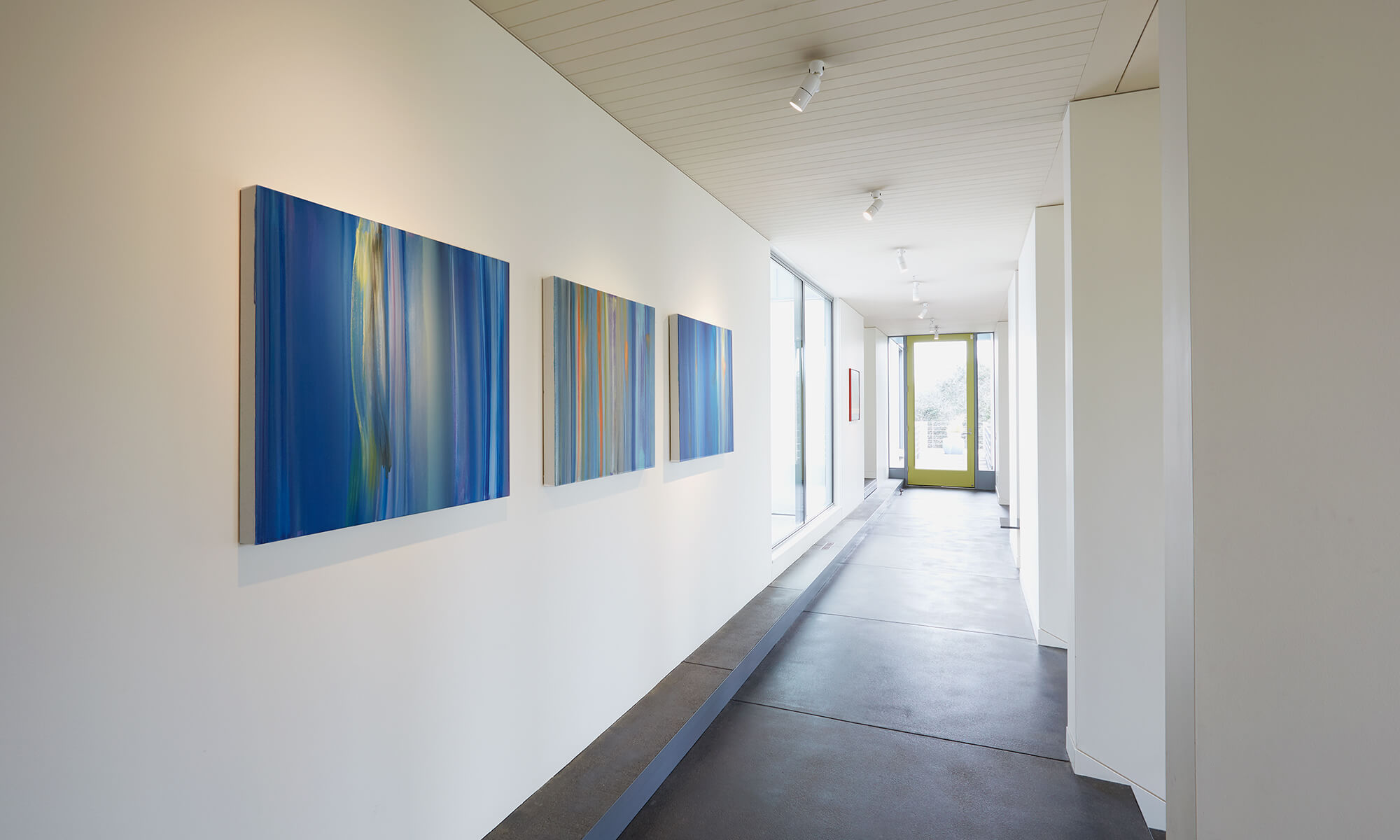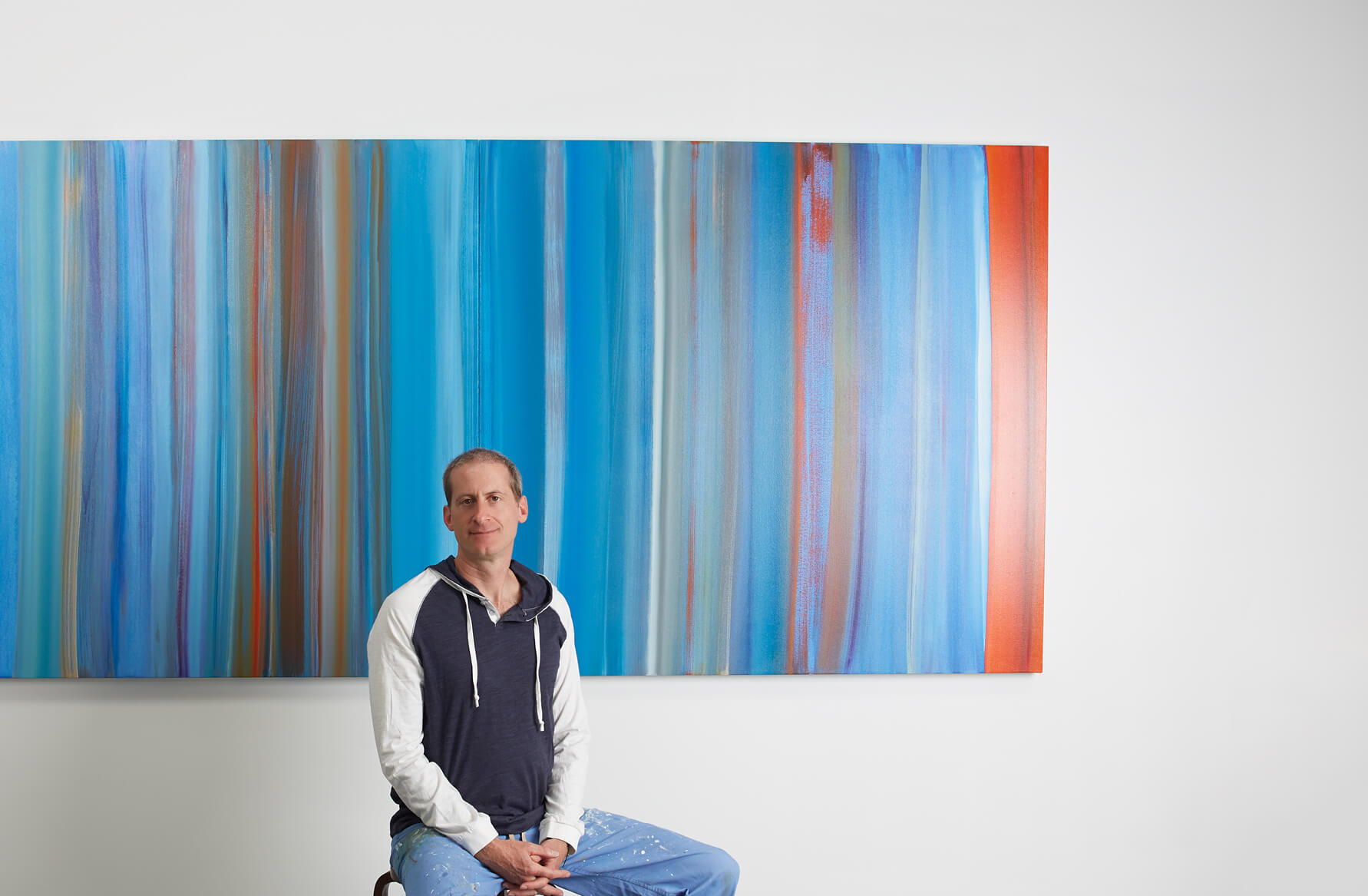At his studio in Santa Fe, New Mexico, Willy Bo Richardson is in his element. Stretching bright swathes of paint across broad canvas, Willy builds his mesmeric abstractions through graceful gestures and bold, harmonized colors.
Before moving to Santa Fe, Willy lived and worked in New York City for a decade, where he immersed himself in the international art scene, earning his M.F.A. in painting from Pratt Institute in 2000. His work has been exhibited alongside renowned modern and contemporary painters, including Josef Albers, Hans Hofmann and Jackson Pollock, and is collected around the world.
TurningArt joined Willy in his studio to learn more about his work and practice, and to listen to his experiences as an artist.
What can you tell us about your journey to becoming a professional artist?
I didn’t think of myself as an artist growing up. I was more the well rounded type. I loved all school subjects and that included but wasn’t limited to art.
Only looking back do I see the obvious…
I spent a good amount of time building model airplanes, gardening, building rock walls, making watercolors, making origami – when I was alone I was making something.
There’s a photo my Mom took when I was still crawling. I arranged all the shoes in the house into a half circle, arranging the different shoes into a pattern. So I’ve always thought about symmetry, pattern, breaking pattern, consonance and dissonance and I’ve always worked with my hands and problem solved with my mind.
My shift towards art as a potential profession didn’t take place until graduate school. Though I studied art and art history in high school and college, I was still debating between writing and painting.
After living a few years in the “real world” I had spent a good amount of time painting and writing alongside working odd jobs and realized that there wasn’t enough of me to paint, write, and make a living, so I decided to pick one. I decided to make writing a personal pleasure and enrolled in the MFA program at Pratt Institute for painting.
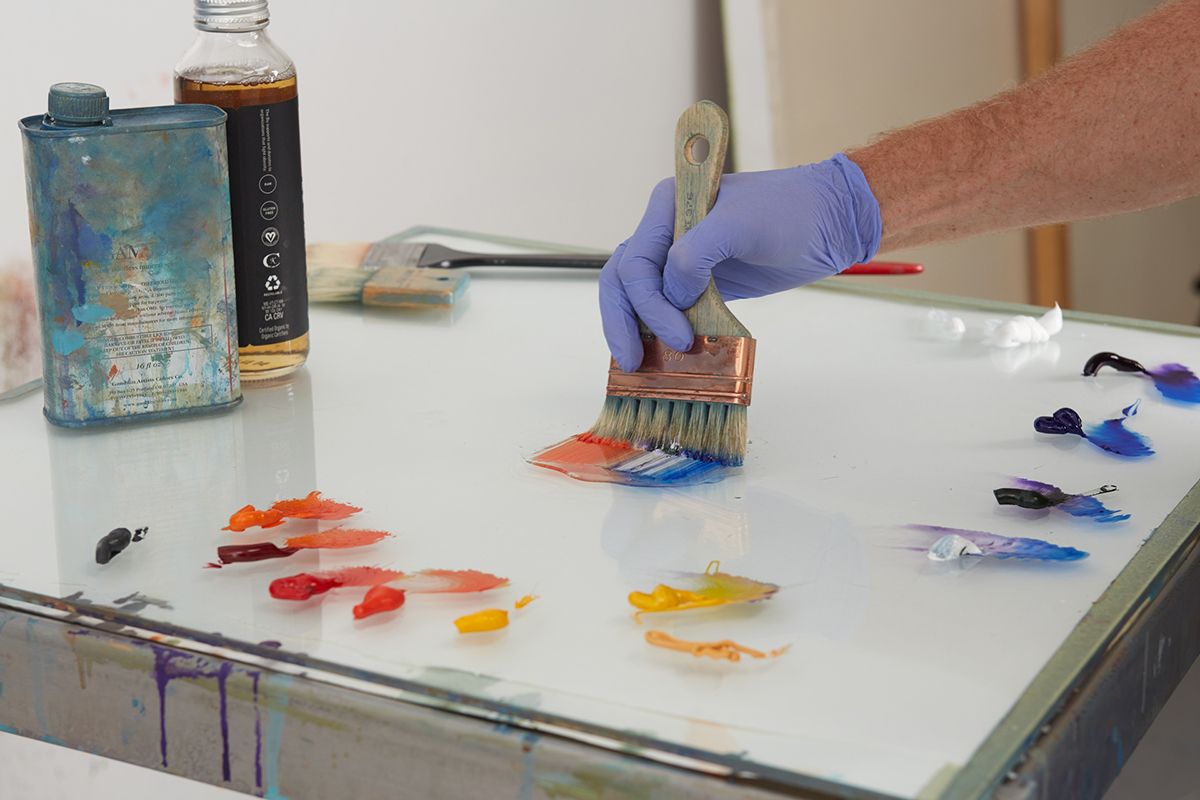
How would you describe your paintings?
I paint with oils and watercolors. I have distilled the painting process down to the most limited structure I could find, which still allows me to push back against limitations with all my might and fury.
This tug of war crackles and sizzles; my paintings influence space and radiate to extend themselves into peoples vision, conversations, and lifestyles.
What is your typical process for beginning a new painting or series?
One painting series leads to the next. A color pattern, an aesthetic problem, or greater world dialogue leads to a question. It always starts with a question…
I then have a clearly (or somewhat clearly) defined problem that can not be resolved through rational thinking. I set to work on the problem, much in the way I imagine a mad scientist or village medicine man sets to work. Though I do have a map, I keep my eyes on the road.
Walk us through a typical day in your studio. What is your routine?
There is no typical workday, and the studio extends into all facets of my life. I am chewing on problems and issues in my family life, meditation practice, martial arts, skiing, readings and studies. The “aha” moments, the big deep life questions, the emotional yearnings – are all studio practice.
If there is a routine, it’s a morning cup of tea, staying active physically, being a good father and husband, keeping up on my reading (I’m currently reading about medieval homes, the Bhagavad Gita, work by Buckminster Fuller, Surely you’re joking, Mr. Feynman, and The Instructions of Gampopa).
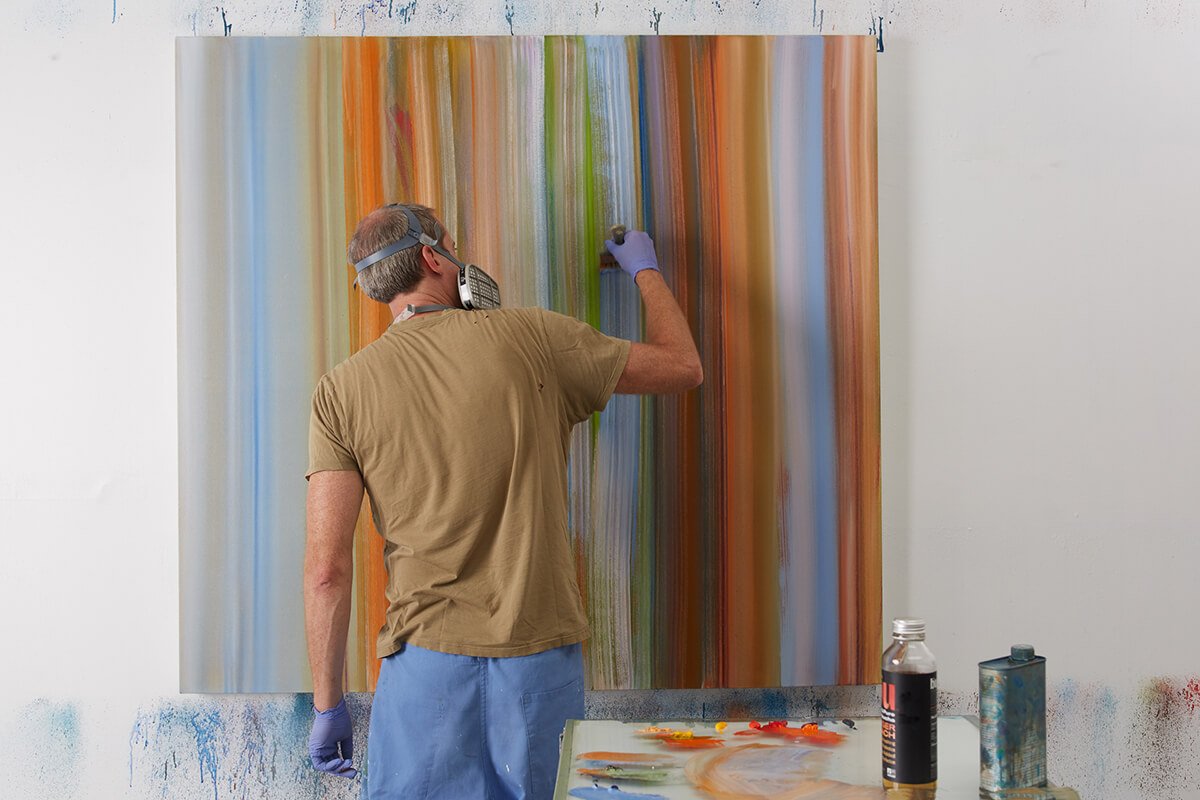
It may seem like I’m making up excuses to not simply state how many hours I spend in my physical studio, but in all actuality, a productive painting session only reflects my life and a life well lived.
What advice do you have for artists who are beginning to build their career? Have there been any habits or strategies that you have adopted that you feel have created more opportunity or visibility for your work?
My advice is to give away all your art until your friends have 3 or more of your paintings. The day you bring a painting over to a friend’s house and they say there’s no more wall space for you, it’s time to show your work to the public.
I speak from experience… this worked for me and has helped fellow artists and students when they were stuck in their studios with too much work piling up.
A friend and colleague at Santa Fe University of Art and Design had me over for a studio visit a few years ago. She was stockpiling her paintings and drawings and couldn’t get anything into the public eye. I told her straight up that she was on the verge of hoarding, building a castle for herself and no one else. She needed to get feedback from others but was waiting for a gallery to swoop down to rescue her. She put too much value into her work and presupposed only a gallery could create a proper setting and produce dialogue.
We have to let it go. We have to start with generosity. I gave away thousands of hours and thousands of dollars worth of art materials for many years before I saw a single penny return.
The week after my studio visit, my friend gifted me a painting, saying this was energetically the beginning of letting her work flow out of her studio. Within a few months she had work in an exhibition at a Museum in Taos!
It works – it really does. Make your studio a river, not a lake.
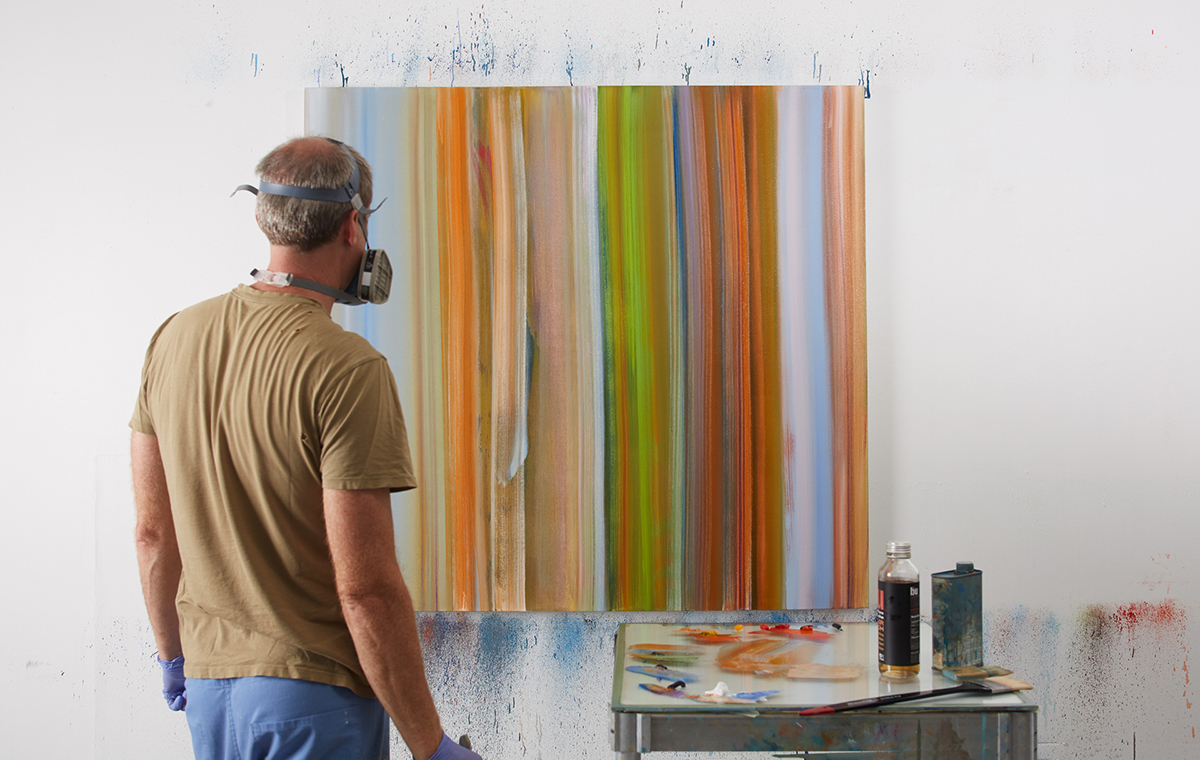
For emerging artists, finding the right rhythm to be productive in the studio can be a challenge, what advice do you have for staying productive and focused?
Emerging artists need to have a lot of chutzpah. The only way to survive those first 10 years out of grad school with just a few people caring about your art… is to have a completely irrational sense of duty and importance.
How else can one explain living and working as all others do, and then in addition want to go to ones studio to make art? It’s like living an additional life.
I gained a bald spot and didn’t get a lot of sleep…
As for advice – in addition to not sleeping much… I personally realized at a certain point, that to make a living as an artist I would have to treat myself as an entrepreneur and business owner. Learning basic marketing, sales and business skills is a must. This is not in direct conflict with the vision of the work. This is in support of manifesting the dream.
What is your advice for combating creative block?
I personally don’t work in the realm of ideation (the formation of ideas or concepts), nor do I work in the realm of discursive thought (proceeding from subject to subject).
So my solution to creative block was to not come up with anything new 🙂
If you are the type of artist that comes up with new and innovative ideas all the time, my advice is to find balance. Take a Brazilian Jiu Jitsu class or study Flamenco, or an other new sport….
Without books, we are hardly human, but one must also nourish the body. Don’t forget your body! A healthy body is naturally confident.
On a more specific art-making level, it’s a good idea to mix up modes of working. Playing with sketchbooks, watercolors; working on less precious materials is always a good way to shake things up.
A stretched and primed canvas can cost a lot of time and money, so working on this surface seems important. Freedom and creative expression needs room for trial and error. Smaller paintings on paper, for example, can loosen up the mind. We aren’t doing rocket surgery. It’s not saving humanity. We’re just making some stuff that communicates the eternal essence of what is always unfolding… no big deal. Relax. Or don’t relax. Have a cup of coffee. Just get off your damn high horse and start moving around – move that body! Shake that mind! Make that art!
How do you see the art market changing? Where you do see yourself in this transition?
The Lascaux cave paintings are somewhere around 20,000 years old. Scattered across Spain, researchers found cave paintings that are more than 65,000 years old – and they were made by neanderthals!
I wonder what type of market they lived in? Just kidding.
Two major trends have shifted everything in the past decade: internet and art fairs. The whole brick and mortar gallery structure is on its head. Another major shift is that real estate prices in New York City have driven artists elsewhere, creating a decentralized creative dialogue. It’s an exciting time to be an artist!
I look for partnerships that are a specific fit for my work. Sometimes partners are galleries, sometimes curators, and of course art consultants and private dealers. Finding a partner like TurningArt is rare and I’m grateful when it fits. Building a career is more than simply selling art. At the core, I have to be in harmony with the people I work with. There must be an idealistic spark and shared vision, and they must love my work. To provide the infrastructure to get my paintings to where they need to go, the relationship must be genuine.
Do you consider yourself, and all artists, to be entrepreneurs? Why or why not?
Before we thought of artists as geniuses, we thought of them as artisans. There is a winding history to how we came to think of artists as rebels, but not a long history. Artists for the most part, throughout European history were entrepreneurial.
During the 7th grade, there was a time when I would go to the candy store after school. This was not for my consumption. The goodies were intended for sales the next day.
I’d buy Blow Pops for 10 cents and sell them on the Capshaw Middle School open market for 25. Why nobody else was doing this, was a total mystery. Even at a premium, my product was in high demand. I was set on a goal- video game cartridges for the Atari 2600.
My English teacher pulled me aside one day and told me I had to go to the principal’s office. The principal told me I was facing suspension, but he’d let me off this time. This was a lot for me to take in. I was an academic achiever. Suspension was for kids who got in fights, not pre-pubescent goodie two-shoes, like myself!
My parents were asked to pick me up from school early, to make the whole event more serious. I don’t remember who picked me up that day, but whichever parent it was, was laughing when they arrived. They defended my enterprise, stating that it was entrepreneurial. That was the day I learned the word entrepreneur, and that was the first time I knew what I wanted to be when I grew up: ambiguous, independent, free, and doing something nobody else had figured out.
Failure is an inevitable part of success in any field. Do you have advice for overcoming setbacks?
Failing is an important part of learning, just don’t call yourself a failure and you’re good to go!
As an artist, how do you measure your success? Can you recall a specific event or milestone(s) in your career that made you feel successful?
I donated a painting through a non-profit called Art Connects New York about 12 years ago. My painting was chosen out of dozens of works to be in the main lobby of the Institute for Career Development, formerly known as the International Center for Disabled.
Not only was I honored that my work was chosen by the curator and staff to be the central piece, some of the low income participants in the program gave me profound feedback and compliments.
It occurred to me that my work is appealing and even healing to the educated and wealthy as well as those in lower classes, uneducated and struggling classes.
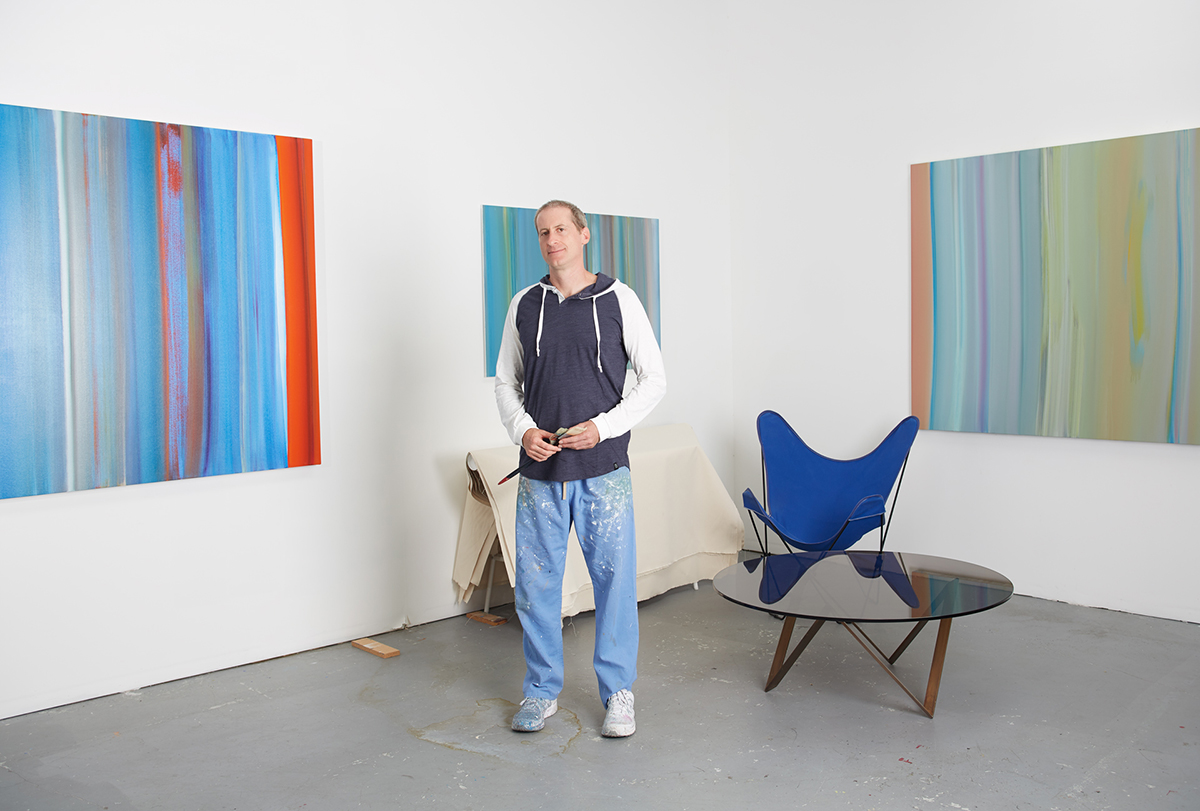
This confirmed for me that all those years working in my mad scientist lab was not for nothing. My wish to truly bring something uplifting and brightening into the world was manifesting, and I had further resolve to keep going, to go big, to work to bring my work and vision to as many people as possible!
What sparked your interest in partnering with TurningArt? Has your experience with TurningArt differed from other art companies you have worked with?
What initially attracted me to TurningArt was the idea that art should be affordable for the middle class. People should be able to at least buy prints, and there’s no reason the prints should be low quality materials or low level artists. There’s a short history lesson in why the art world once looked down on reproductions which would be too lengthy to get into now…
Point is, there is a (dissolving) belief that an original work’s value will be tarnished by an open-editioned print. The print doesn’t do the tarnishing though, it’s only an outdated and snobby notion created by fine art market makers. This snob concept is based on outdated distribution and printing models. Paradigms are shifting, and I say this with great pleasure, because a few of us kids on the playground have it figured out.
So my original attraction was idealistic. I didn’t know that my partnership with TurningArt would become lucrative in a few years, especially with renting originals – which is genius.
Article Found in TurningArt – In Studio: Willy Bo Richardson

